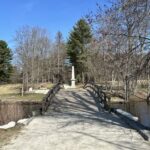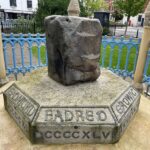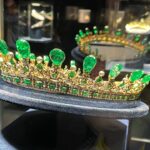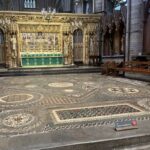Historical Places to Visit in England

My first independent overseas trip was a spring break trip to London when I was in college. My friends were going to sunny beaches to party – I was thrilled to stand in the drizzle and gawk up at St Paul’s Cathedral. I usually prefer the country to the city, but London is one place I don’t think I’ll ever get sick of! Luckily, I have a very easy-going husband who lets me drag him all over the UK.
Typically, I fly into London and then go from there. Trains are very easy to navigate and they take you all over the country. I’ve taken the Caledonia Sleeper overnight to Edinburgh, Scotland and various regional & national trains. Renting a car is also easy at Heathrow and I’ve always found roads in England (and the UK in general) pretty easy to navigate, especially with a gps device or phone mapping.
HISTORY
[bg_collapse view=”link” color=”#4a4949″ icon=”arrow” expand_text=”Show More” collapse_text=”Show Less” ]
For a very abridged version of England’s history, we start waaaay back in prehistoric times. This is where we find structures like Stonehenge or Avebury, circa 2500 BC. Bronze Age artisans created some really impressive metal and stone jewelry and began living in hillforts, or defensive enclosures for a community. These structures became more expansive and the metalworking improved in the Iron Age, when tribal centers ruled and soon saw the arrival of Julius Caesar in 55 BC.
Native Britons resisted Roman occupation for nearly 100 years until Emperor Claudius got a foothold and the conquest began. Knowing where enough was enough, Hadrian began construction on his famous wall in 122 AD to protect Britannia from the troublesome Picts in the North. It lasted a couple centuries but by the mid-300’s “barbarian” invasions from the North and abroad destabilized the region enough that the Romans, who were seeing their own might decline across Europe, began to withdraw in 410 AD.
Enter the Anglo-Saxons – and many others! The period from the departure of the Romans to the Norman conquest is hard to study because there aren’t great records from the period but there are still amazing finds, like the burial mound at Sutton Hoo from around 625 AD. Multiple smaller kingdoms ruled somewhat independently of each other…until the Vikings started showing up to plunder the tempting wealth of the monastaries.
The Vikings were sweeping the island until King Alfred of Wessex finally defeated them soundly in 878 AD. Part of the peace agreement allowed the Danes to retain control of their previously conquered lands, which became known as the Danelaw. AEthelstan is regarded as the first King of England following his defeat of the last Vikings on the island in 927 AD. They didn’t stay out for long and for a time the Kings of Denmark and Norway also held the English crown.
>>Note to self: I really need to read more about Emma of Normandy (AElfgifu to the Anglo-Saxons). After her first husband, English King AEthelred died, she later married the Danish King Cnute, whose father preceded her first husband as King of England, and later became King himself. So not only was she twice the Queen of England but she also became Queen of Denmark and Norway. Sons from each husband would eventually rule, which I think is just a fascinating dynamic.<<
The Battle of Hastings in 1066 AD ushered in the Norman period and the era of castle-building began. Norman Kings (and Queens – looking at you, Eleanor of Aquitaine!) are a really fascinating lot to study. Here’s where we get to the Crusades, Thomas Beckett, the Bubonic Plague and the War of the Roses, which finally closes with the end of Plantagenet (Norman) rule in 1485 AD at the Battle of Bosworth Field when a young upstart by the name of Tudor bursts onto the scene.
From this period, Henry VIII and daughter Elizabeth I likely need no introduction if you’ve read this far! The Tudors will definitely get their fare share of posts, as will the subsequent periods of Stuarts, Georgians and Victorians.
The best part is you can often experience all of these periods of history in one location. Hampton Court Palace is a great example: built during the Tudor reign and expanded by William and Mary it really does feel like you’ve found a Time Machine to travel 200 years via a staircase.
References:
English Heritage. Story of England. Accessed 1 May 2021.
Wikipedia. History of England. Accessed 30 April 2021.
[/bg_collapse]
- Currency: British Pound (save anything left for the other countries of the UK: Scotland, Wales or Northern Ireland - even though the "Bank of" name will be different I rarely have an issue using pounds from one country in another); I use ATMs to get cash, though this can be harder to find in smaller towns. I've also found that credit cards are easy and convenient (I've used VISA & Master Card)
- Weather: Generally cool & temperate. I did hit a heat wave in 2019 but otherwise layers and a good raincoat is always a safe option
- Ice cream: It's everywhere. For a country that is generally cloudy and cool, ice cream trucks are bountiful and always a welcome sight; get a "99"
- Mind the Gap: Travel on the Tube in London is easy and straightforward. On all my trips since 2019, I could pay at turnstiles with Apple Pay through my iPhone; it was awesome. No cards to buy or "top off"- I believe it works with any contactless phone or credit card with this capability (look for the curved lines icon)
British Slang
A quick British-to-American English phrase guide











